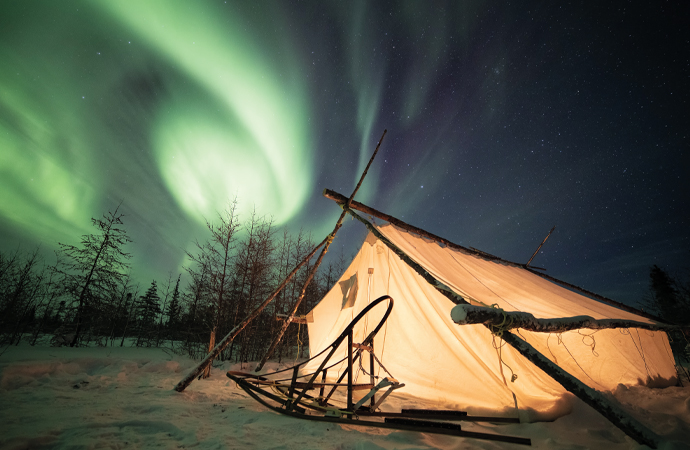Indigenous Tourism Experiences Are Growing in Canada
Excursions aim to foster real exchange between visitors and Indigenous communities
by Todd Plummer
August 7, 2023

Squamish Lil’wat Cultural Centre, Whistler, Canada / Photo: Courtesy of ITAC/Logan Swayze
Summer in the Arctic Circle is actually quite idyllic—who knew? Twenty-four hours of blinding sun warms the air into the balmy 60s and 70s, and every now and again a frigid polar gust proves surprisingly refreshing. It’s perfect exploration weather. And having gone for a dip in the Beaufort Sea at the height of summer, I can confirm that the water there was not much colder than any of my childhood beaches in Maine. Travel is all about closing the gap between what we know and what we think we know, right?
Of course, the far north of Canada’s Northwest Territories is inhospitable country, and the weather can turn on a dime. As we drove up the Inuvik-Tuktoyaktuk Highway, which soars over the widest, most beyond vast land I have ever seen, blasts of polar air threatened to flay the sides right off our van. I wondered, How did people live up here before cars, Arc’teryx jackets or grocery stores?

Arctic aurora, seen during a Wapusk Adventures experience / Photo: Courtesy of ITAC/Daniel Raiti
We were on a mission: to drive the first all-weather road to Canada’s Arctic Coast. Previously, communities this far north could only be reached by car in the winter months, when a veneer of snow and ice would smooth the choppy dirt roads enough to make them passable. But this highway, opened in 2017, made it possible to drive year-round to the Inuvialuit settlement of Tuktoyaktuk. For the first time, a regular person with a regular car (or perhaps a Jeep) can theoretically drive from Florida to the Arctic Ocean in about 80 hours flat.
The eye-opening excursion was part of a multiday package with Tundra North Tours, a company owned and operated by Kylik Kisoun Taylor, who specializes in sharing transformational Indigenous experiences with visitors—think reindeer herding, building igloos, sampling foods such as muktuk (whale blubber), and encountering Indigenous leaders and artisans. This year, Taylor received an Indspire Award recognizing his contributions to socially responsible tourism in Canada’s north.
In addition to driving to Tuktoyaktuk, Taylor took us fishing on the Mackenzie River, where he used age-old, passed-down methods to pull fish from the water as easily as one would pick grapes off the vine. Taylor’s tours feel practical, illustrative and engaging—and in no way tokenistic. They aren’t about going somewhere, taking a picture, and leaving. The goal is to foster real exchange between visitors and Indigenous communities. He wants guests to feel like they’ve not only learned something, but also felt something, and perhaps been stirred to think a little more critically about Indigenous people and their place in the world.

Haida Heritage Center, Graham Island, Canada / Photo: Courtesy of ITAC/Jason Shafto
“Tourism is by far the best avenue for reconnecting culture and resource,” says Taylor. The pressures of earning a living to exist in a colonized Canada has caused a disconnect between Indigenous people and their traditional ways of life, but tourism has the opportunity to change that. “For me as an Inuit person, I can’t afford or have the time to go out onto the land to practice my tradition—but it’s my job now. I get to go out and practice it all the time and be out on the land while making a living.”
Taylor’s is one of an estimated 1,889 businesses in Canada’s Indigenous tourism sector, according to a study from the Indigenous Tourism Association of Canada (ITAC). That figure includes everything from adventurous outfitters in the farthest reaches of Northern Canada to more approachable outfits such as Talaysay Tours, which offers Indigenous-centered walking tours of Stanley Park in the heart of Vancouver.
In 2019, ITAC reported that Indigenous tourism contributed $1.78 billion and 37,000 jobs to Canada’s economy. And while Covid caused “drastic losses” to those numbers, the sector is expected to bounce back to $1.9 billion and 49,000 jobs by next year. ITAC CEO and president Keith Henry anticipates those numbers to grow to $6 billion and 60,000 jobs by 2030. By every measure, this is a market growing by leaps and bounds.
“We are one of the few countries with an Indigenous-led association devoted specifically to the Indigenous tourism industry,” says Henry. “Indigenous communities in Canada have a deep connection to the land and often have initiatives that promote eco-friendly practices. These make Canada a rewarding destination for travelers seeking meaningful cultural experiences and a deeper connection with Indigenous heritage.” Having lived in and traveled around Canada extensively, I can unequivocally say that some of my most lasting and impactful experiences there were in the Indigenous realm, from searching old-growth rainforests for century-old totem poles in the Haida Gwaii archipelago (on a Maple Leaf Adventures expedition) to dogsledding with the Métis through the polar-bear territories of Churchill, Manitoba (with Wapusk Adventures).
Many of these experiences might feel off the beaten path relative to Canada’s well-worn tourist tracks—skiing at Whistler, ascending Toronto’s CN Tower and so forth. But they serve as important testaments that travel, at its best, forces us to think critically about who we are, how we got here and our relationship to the lands we inhabit.




